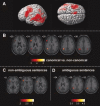An fMRI study of canonical and noncanonical word order in German
- PMID: 17274018
- PMCID: PMC6871458
- DOI: 10.1002/hbm.20318
An fMRI study of canonical and noncanonical word order in German
Abstract
Understanding a complex sentence requires the processing of information at different (e.g., phonological, semantic, and syntactic) levels, the intermediate storage of this information and the unification of this information to compute the meaning of the sentence information. The present investigation homed in on two aspects of sentence processing: working memory and reanalysis. Event-related functional MRI was used in 12 healthy native speakers of German, while they read sentences. Half of the sentences had unambiguous initial noun-phrases (masculine nominative, masculine accusative) and thus signaled subject-first (canonical) or object-first (noncanonical) sentences. Noncanonical unambiguous sentences were supposed to entail greater demand on working memory, because of their more complex syntactic structure. The other half of the sentences had case-ambiguous initial noun-phrases (feminine gender). Only the second unambiguous noun-phrase (eighth position in the sentences) revealed, whether a canonical or noncanonical word order was present. Based on previous data it was hypothesized that ambiguous noncanonical sentences required a recomputation of the sentence, as subjects would initially commit to a subject first reading. In the respective contrasts two main areas of brain activation were observed. Unambiguous noncanonical sentences elicited more activation in left inferior frontal cortex relative unambiguous canonical sentences. This was interpreted in conjunction with the greater demands on working memory in the former condition. For noncanonical ambiguous relative to canonical ambiguous sentences, an activation of the left supramarginal gyrus was revealed, which was interpreted as a reflection of the reanalysis-requirements induced by this condition.
Wiley-Liss, Inc.
Figures



Similar articles
-
Native and non-native reading of sentences: an fMRI experiment.Neuroimage. 2006 May 15;31(1):354-65. doi: 10.1016/j.neuroimage.2005.11.047. Epub 2006 Jan 19. Neuroimage. 2006. PMID: 16427323
-
Revisiting the role of Broca's area in sentence processing: syntactic integration versus syntactic working memory.Hum Brain Mapp. 2005 Feb;24(2):79-91. doi: 10.1002/hbm.20070. Hum Brain Mapp. 2005. PMID: 15455462 Free PMC article.
-
Neural aspects of sentence comprehension: syntactic complexity, reversibility, and reanalysis.Cereb Cortex. 2010 Aug;20(8):1853-64. doi: 10.1093/cercor/bhp249. Epub 2009 Nov 17. Cereb Cortex. 2010. PMID: 19920058 Free PMC article.
-
Lateralization of auditory language functions: a dynamic dual pathway model.Brain Lang. 2004 May;89(2):267-76. doi: 10.1016/S0093-934X(03)00351-1. Brain Lang. 2004. PMID: 15068909 Review.
-
The role of variation in phonological and semantic working memory capacities in sentence comprehension: neural evidence from healthy and brain-damaged individuals.Cogn Affect Behav Neurosci. 2025 Feb;25(1):240-262. doi: 10.3758/s13415-024-01217-5. Epub 2024 Sep 13. Cogn Affect Behav Neurosci. 2025. PMID: 39271594 Review.
Cited by
-
Left inferior frontal activations depending on the canonicity determined by the argument structures of ditransitive sentences: an MEG study.PLoS One. 2012;7(5):e37192. doi: 10.1371/journal.pone.0037192. Epub 2012 May 22. PLoS One. 2012. PMID: 22629366 Free PMC article.
-
Expecting Questions Modulates Cognitive Effort in a Syntactic Processing Task: Evidence From Pupillometry.J Speech Lang Hear Res. 2021 Jan 14;64(1):121-133. doi: 10.1044/2020_JSLHR-20-00071. Epub 2020 Dec 29. J Speech Lang Hear Res. 2021. PMID: 33375842 Free PMC article.
-
Distinct neural correlates of morphosyntactic and thematic comprehension processes in aphasia.Brain Commun. 2025 Mar 24;7(2):fcaf093. doi: 10.1093/braincomms/fcaf093. eCollection 2025. Brain Commun. 2025. PMID: 40129862 Free PMC article.
-
Functional organization of the language network in three- and six-year-old children.Neuropsychologia. 2017 Apr;98:24-33. doi: 10.1016/j.neuropsychologia.2016.08.014. Epub 2016 Aug 16. Neuropsychologia. 2017. PMID: 27542319 Free PMC article.
-
Preschoolers' brains rely on semantic cues prior to the mastery of syntax during sentence comprehension.Neuroimage. 2016 Feb 1;126:256-66. doi: 10.1016/j.neuroimage.2015.10.036. Epub 2015 Oct 20. Neuroimage. 2016. PMID: 26497266 Free PMC article.
References
-
- Bates EA,Friederici AD,Wulfeck BB,Juarez LA( 1988): On the preservation of word order in aphasia: Cross‐linguistic evidence. Brain Lang 33: 323–364. - PubMed
-
- Ben‐Shachar M,Hendler T,Kahn I,Ben‐Bashat D,Grodzinsky Y ( 2003): The neural reality of syntactic transformations: Evidence from functional magnetic resonance imaging. Psychol Sci 14: 433–440. - PubMed
-
- Bornkessel I,Zysset S,Friederici AD,von Cramon DY,Schlesewsky M ( 2005): Who did what to whom? The neural basis of argument hierarchies during language comprehension. Neuroimage 26: 221–233. - PubMed
-
- Brown CM,van Berkum JJ,Hagoort P ( 2000): Discourse before gender: An event‐related brain potential study on the interplay of semantic and syntactic information during spoken language understanding. J Psycholinguist Res 29: 53–68. - PubMed
-
- Caplan D ( 2001): Functional neuroimaging studies of syntactic processing. J Psycholinguist Res 30: 297–320. - PubMed
Publication types
MeSH terms
LinkOut - more resources
Full Text Sources

